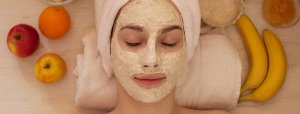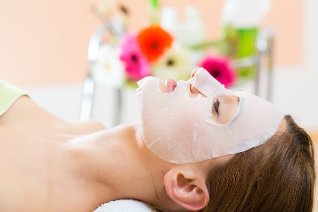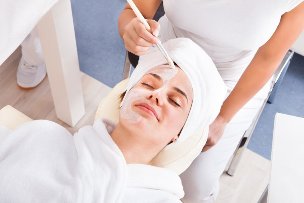
The cosmetics industry produces tons of masks offered for use both in professional salons and at home. However, home-made face masks made from natural ingredients will always be superior to factory-made options.
After 25 years, girls should start caring for their faces and not only wash with clean water, but also nourish them with various masks. Otherwise, inadequate care will manifest itself in early facial wrinkles and a significant deterioration of the skin condition.
What face masks are there?
Typically, face masks are classified according to the effect they produce. There are types of masks:
- nourishing, moisturizing, toning and cleansing - designed for perfect skin care and care in perfect condition;
- anti-inflammatory, whitening, anti-couperose - this group of masks successfully combats obvious skin imperfections;
- anti-aging, lifting masks - belongs to the group of anti-aging and helps to tighten the skin.
How to determine your skin type
Before choosing a face mask, you need to determine your skin type. It is customary in classical cosmetology to distinguish skin types:
- thick,
- dry,
- normal,
- merged.
Since the needs of different skins are significantly different, a homemade face mask should be chosen depending on your skin type.
As a rule, this is not a problem, because girls usually pay attention to their appearance, and their skin type can be easily determined by looking at themselves in the mirror. But sometimes there are difficulties. Therefore, to determine your skin type at home, wash your face with normal neutral soap and do not use any products on it.
After about an hour and a half, put a well-absorbent paper towel firmly on your face. Look closely at the napkin and assess the degree of oily skin:
- If there is a trace of sebum on the entire surface of the napkin, it means that the skin is completely empty and you have oily skin type.
- If there are no traces left on the napkin, but the skin does not peel and thicken, then your skin type is normal.
- If there is no oily mark on the napkin, but you feel an obvious tightness, then your skin is dry.
- If your forehead, nose and chin are boldly traced in the center of the napkin and the skin does not leave a mark on the cheeks and temples (dry or normal), then such an uneven distribution of oil content indicates a combination or combination skin type.
Nourishing face masks at home

The skin needs nourishing masks to fill the lack of nutrients, vitamins and trace elements.
Recipe # 1. Nourishing mask for oily skin (honey)
A simple composition made of 2 teaspoons of honey, 20 drops of lemon juice and 1 tablespoon of low-fat sour cream is ideal for oily skin. Mix all ingredients in a bowl until smooth, apply the resulting mixture on your face. Leave on for 20 minutes to half an hour, then rinse with warm water.
The mask will nourish the skin and give it equal color, radiance and beauty.
Recipe number 2. Nourishing mask for dry skin
Use the following ingredients to nourish dry skin at home:
- 1 egg yolk,
- 2 teaspoons of milk,
- 1 half tablespoon fine oat kernels.
Pour oatmeal with very hot milk, soak a little (10-15 minutes). Beat the egg yolks with a fork and mix the shells. Apply the mass on your face and hold for 20 minutes.
This soothing mask, which penetrates deep into the pores, nourishes dry skin, eliminates the feeling of tightness and peeling, leaving it soft and velvety.
Recipe number 3. Nourishing mask for normal skin
It is a big misconception that normal facial skin does not need nourishment and care, saturation with vitamins. Grape-based nourishing mask for normal skin gently and carefully cares for the skin, soothes.
Crush 6-7 grapes (or as a last resort) from any white variety, take all the seeds and peels, combine the grape mass with 1 tablespoon of sour cream. Apply the mass on your face, leave on for 20-30 minutes, then rinse with warm water. The mask is so nourishing that it can heal irritated skin.
Moisturizing masks at home
Natural moisturizing face masks moisturize your skin. Hydration is often needed in the spring and summer, when part of the moisture is lost from the surface layers of the skin under the influence of ultraviolet radiation and ambient temperature. Even mild dehydration can lead to decreased skin elasticity, lacquerness and wrinkles.
Recipe number 4. Moisturizing masks for oily skin
The following recipe will help moisturize oily skin. Beat 1 egg white and mix with 20 ml of liquid honey until smooth. Add 1 tablespoon chopped oatmeal. Apply the mask on your face, leave on for 20 minutes. First wash with warm water, then wash your face with cold. You can replace the peels with potatoes or starch to help tighten pores and nourish your skin.
Recipe number 5. Moisturizing masks for dry skin
Dryness is perfectly removed with a curd mask.
Dry skin needs to be hydrated at any time of the year, not especially in summer and spring. Mix about 30 grams of normal fat cheese with 2 tablespoons of milk, warmed to body temperature. Bring the mass to a homogeneous consistency without rounding. Apply the mask on the skin for 15 minutes. Rinse with warm water.
Recipe number 6. Moisturizing masks for normal skin
Use a grapefruit mask to moisturize normal skin. To do this, mix the chopped pulp of two grapefruit slices with 1 egg yolk. Apply the mask on the skin for 15 minutes. Then rinse with warm water.
Toning and cleaning homemade face masks
Cleansing and toning masks have a general strengthening effect on the skin, activate the subcutaneous blood circulation and cleanse the pores of the face from oily secretions, giving it a youthful appearance.
Recipe number 7. Toning mask for oily skin
Oily skin is perfectly toned with a white clay mask. To prepare, dissolve 2 tablespoons of white clay in cold boiled water, add 1 egg white, 3-4 drops of lemon juice and 5 ml of honey. The resulting homogeneous mass should resemble sour cream in terms of consistency. Apply the mask on your face and wait until it is completely dry. Rinse the clay mask with warm water until it is completely dry.
Recipe # 8. Cleansing mask for dry skin
Dry skin is visibly improved and cleansed under the influence of white clay. To prepare the mask at home, take 1 tablespoon of white clay, 2 times more milk and 5 ml of honey. Mix until smooth and apply on face. After 10-15 minutes, rinse the mask and finally use a moisturizer after cleansing.
Recipe # 9. Toning mask for normal skin
Normal-skin with lemon peel face mask will quickly restore freshness and firmness. Mix 1 yolk and 20 ml of low-fat sour cream, add finely chopped lemon juice. Do not leave the mask on your face for more than 30 minutes.
Whitening homemade face masks
Many girls dream of getting rid of freckles and generally whitening their face. Bleaching face masks at home will help lighten age spots and even age spots.
Recipe number 10. Cucumber whitening mask is known to everyone with a good effect. Finely chop a medium-sized cucumber (no seeds) and mix with daily nourishing cream or sour cream. Apply the mass on your face for 20 minutes. Rinse with warm water.
Recipe # 11. The following whitening face mask is very liquid. At home, mix liquid honey and lemon juice in equal parts by volume. Soak the resulting gauze napkins, then put on your face. Leave on for 15 minutes, then remove the tissues and wash your face gently with water.
Home anti-aging face masks
Over time, the skin begins to age - this is an inevitable process. However, you should not lose heart when the first problem wrinkles appear, but you should add a rejuvenation procedure to your regular skin care. Regular use of anti-aging collagen masks allows you to delay the appearance of new age-related changes in your skin and smooth out existing small wrinkles.
Recipe number 12. Aloe vera rejuvenating homemade mask is very popular at home. Combine a tablespoon of this plant juice with the same amount of nourishing face cream and premium vegetable oil (preferably olive oil). Mix and apply the mask a little warm, leave on face for 10 minutes.
Recipe # 13. In the spring you can make a mask from fresh plantain leaves. Peel a squash, grate it and mix with honey. If the mixture is too thick, dilute it a little with water, like a gelatinous mixture. Keep this flavor on your face for at least 15 minutes. First remove with a damp stick, then wash your face with cool water. And there is no need for botulinum toxin.
Lifting masks for the face at home
Fighting sagging skin on the face requires constant attention from women over 30 years. Therefore, when the skin begins to fade, you should be armed with time-tested means that will help to correct the top layer of the epidermis.
Recipe # 14. This vitamin anti-aging face mask is made from home pharmacy ingredients.
Contents:
- 1 tablespoon of assembled pink clay
- 1 ampoule of vitamin A
- 30 ml of unscented green tea is brewed.

Slowly dilute the dry clay with tea and bring the mass to a homogeneous texture, stirring constantly. Add vitamin A and apply the mixture all over the skin. The mask lasts 25 minutes. Regular use of this recipe restores skin firmness and health.
Rinse this mask with plenty of cool water.
Tariff # 15. A natural and effective lifting can be observed in egg white. Whisk a protein into a stiff foam and mix with two teaspoons of soaked oatmeal. The duration of the mask on the skin is 15 minutes.
For girls, there is a lifting effect: there is a tightening of the skin.
How to properly apply a face mask at home
Before applying any mask, you should clean your face from decorative cosmetics with a gentle make-up remover. A refreshing gel usually completes the makeup removal procedure, but you can use an extra peel.
Pre-exfoliation of dead cells is desirable for good penetration of all the substances that make up the mask into the skin, which will ensure its maximum effectiveness. The scrub can also be used at home, for example in any coffee scrub recipe.
Follow the general rules for home cosmetic recipes when applying the mask:
- The mask application procedure cannot be "run". Put all the housework aside and spend half an hour just on yourself.
- Any effective home-made face mask should be prepared (mixed) immediately before use. The remaining mass cannot be stored.
- All components of the mask should be of high quality and include sour cream, fruit, kefir, etc. Ingredients such as must be fresh.
- Before applying the mask, the face should be cleaned as usual. Owners of oily and combination skin will probably need an exfoliating peel first. After cleansing the skin, open the pores as much as possible, you can steam in the bath or apply a warm, moist compress. This will allow all the ingredients to be absorbed as much as possible and have the best effect.
- To prevent hair from falling on your face, wrap it in breadcrumbs and secure it with something.
- The mask should be applied with clean hands, a brush, gauze or cotton pad for consistency.
- Most masks should be applied not only on the face, but also on the neck and décolleté. The exception will be drying masks for oily skin, because the skin in the décolleté area is drier.
- Apply the homemade mask along the massage lines, moving from the middle of the face to the temples. The exception is the skin directly around the eyes; no need to wear a mask.
- Rinse the mask with clean water. It is better not to take it from the tap, it is necessary to prepare a pot of boiled water cooled to body temperature in advance.
- You don't need to wipe your face after washing the mask, gently stain excess moisture with a clean towel. On a damp face, apply a cream that suits your skin type.
- Do not expect immediate effect from the first procedure. Homemade face masks should be repeated regularly at intervals of 1-3 times a week. The course duration should be at least 3 weeks.
Precautions when using home masks
It is important to do a test on the wrist or elbow before applying the mask at home for girls prone to allergies. If signs of an allergic reaction appear, take an antihistamine and do not use this product.














































































